MANU1381: Analysis of Telstra's Sustainable Engineering Systems
VerifiedAdded on 2023/06/06
|17
|4984
|59
Report
AI Summary
This report provides a comprehensive analysis of Telstra's sustainable engineering systems and its impact on the environment. It begins with an introduction that outlines the background and system selection, followed by a detailed characterization of Telstra, including its objectives, environment, and subsystems like Sales, Technical, HR, Telstra Wholesale, Telstra Enterprise, Telstra Consumer, and Government. The report examines the elements and attributes of each subsystem, their interrelationships, and the overall system complexity. It delves into the dynamics of the system, including stakeholder analysis and the application of system methodology. The report also discusses the problems Telstra faces and the application of hard versus soft systems approaches. The conclusion summarizes the key findings and implications of the analysis, highlighting Telstra's commitment to sustainable practices and its role in the telecommunications industry.

MANU1381 Sustainable
Engineering Systems and
Environment
Engineering Systems and
Environment
Paraphrase This Document
Need a fresh take? Get an instant paraphrase of this document with our AI Paraphraser
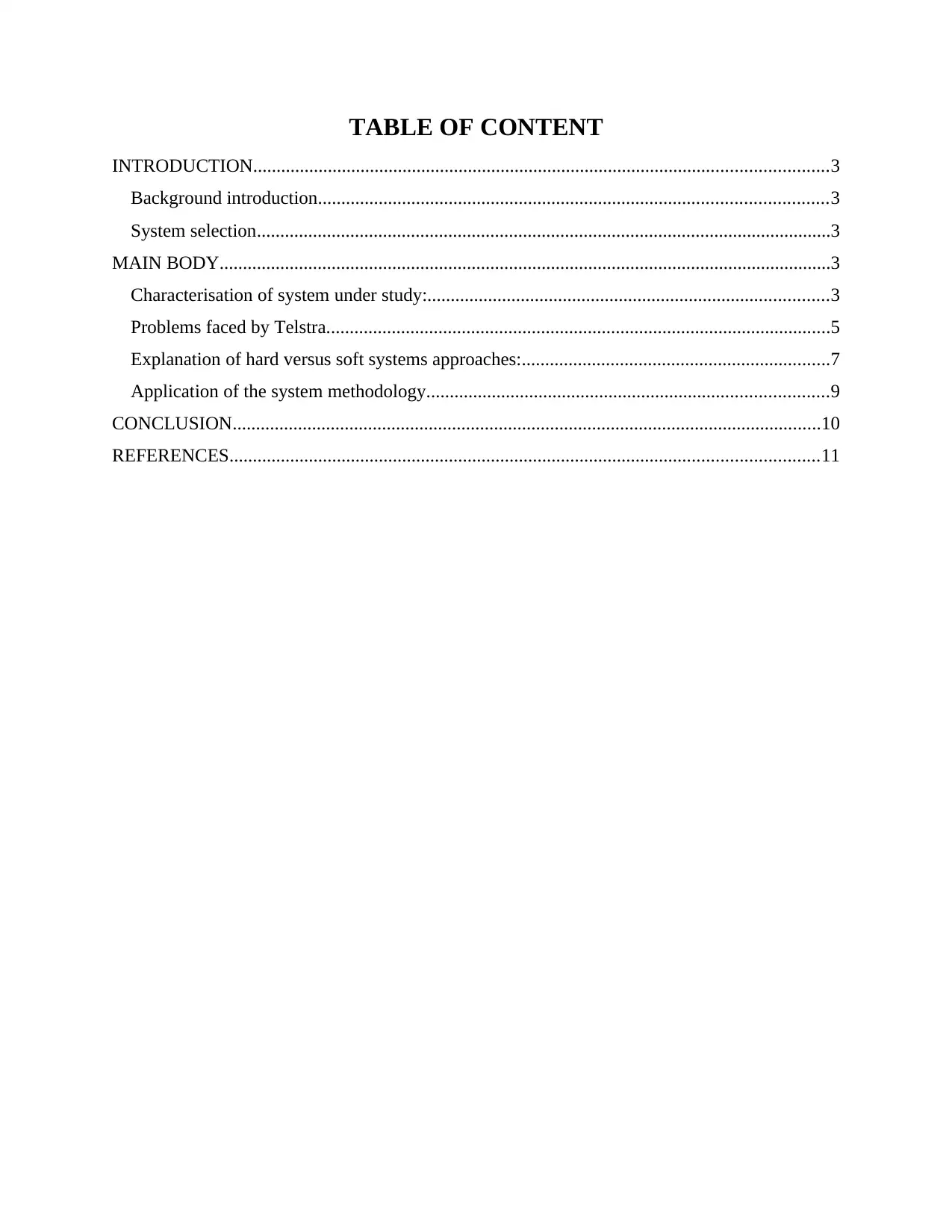
TABLE OF CONTENT
INTRODUCTION...........................................................................................................................3
Background introduction.............................................................................................................3
System selection...........................................................................................................................3
MAIN BODY...................................................................................................................................3
Characterisation of system under study:......................................................................................3
Problems faced by Telstra............................................................................................................5
Explanation of hard versus soft systems approaches:..................................................................7
Application of the system methodology......................................................................................9
CONCLUSION..............................................................................................................................10
REFERENCES..............................................................................................................................11
INTRODUCTION...........................................................................................................................3
Background introduction.............................................................................................................3
System selection...........................................................................................................................3
MAIN BODY...................................................................................................................................3
Characterisation of system under study:......................................................................................3
Problems faced by Telstra............................................................................................................5
Explanation of hard versus soft systems approaches:..................................................................7
Application of the system methodology......................................................................................9
CONCLUSION..............................................................................................................................10
REFERENCES..............................................................................................................................11
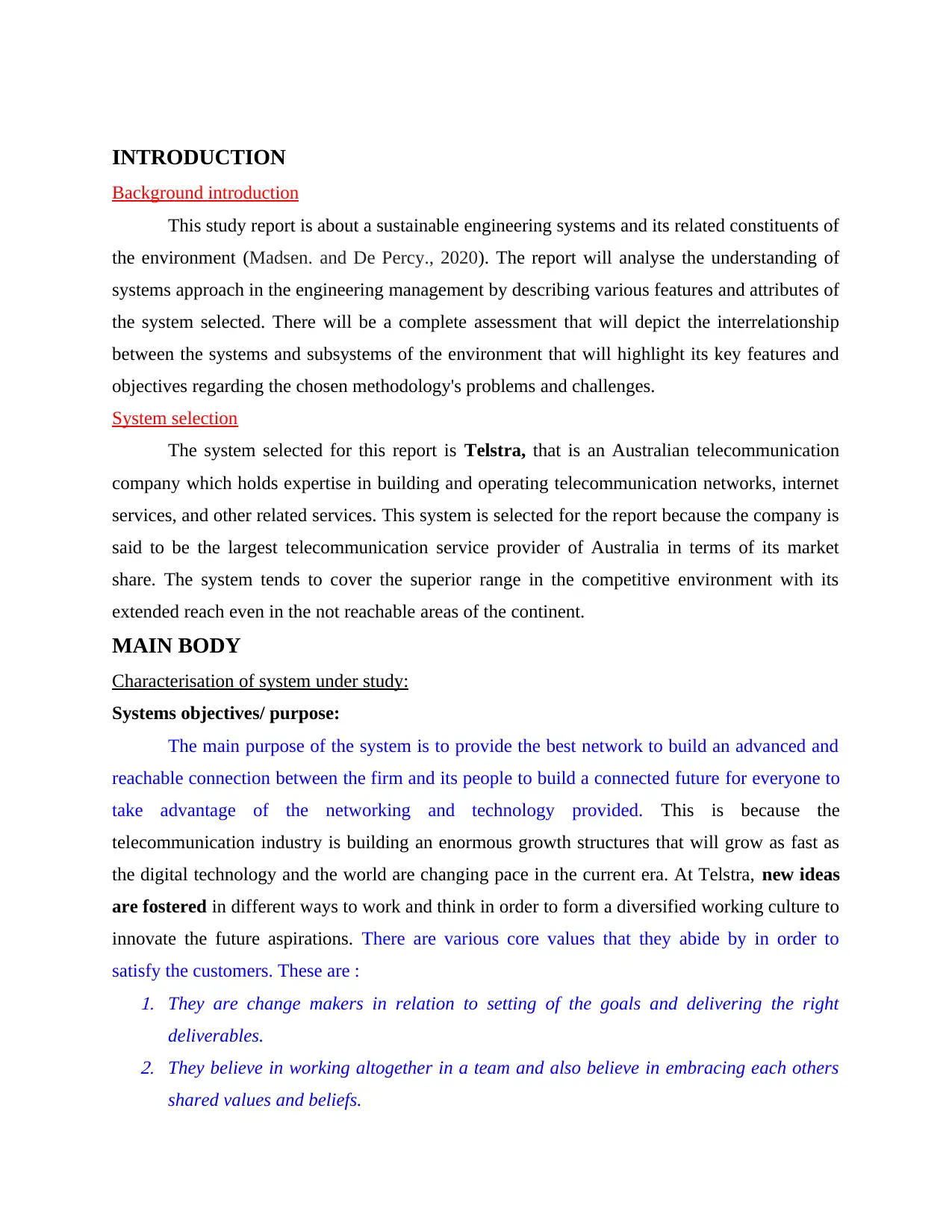
INTRODUCTION
Background introduction
This study report is about a sustainable engineering systems and its related constituents of
the environment (Madsen. and De Percy., 2020). The report will analyse the understanding of
systems approach in the engineering management by describing various features and attributes of
the system selected. There will be a complete assessment that will depict the interrelationship
between the systems and subsystems of the environment that will highlight its key features and
objectives regarding the chosen methodology's problems and challenges.
System selection
The system selected for this report is Telstra, that is an Australian telecommunication
company which holds expertise in building and operating telecommunication networks, internet
services, and other related services. This system is selected for the report because the company is
said to be the largest telecommunication service provider of Australia in terms of its market
share. The system tends to cover the superior range in the competitive environment with its
extended reach even in the not reachable areas of the continent.
MAIN BODY
Characterisation of system under study:
Systems objectives/ purpose:
The main purpose of the system is to provide the best network to build an advanced and
reachable connection between the firm and its people to build a connected future for everyone to
take advantage of the networking and technology provided. This is because the
telecommunication industry is building an enormous growth structures that will grow as fast as
the digital technology and the world are changing pace in the current era. At Telstra, new ideas
are fostered in different ways to work and think in order to form a diversified working culture to
innovate the future aspirations. There are various core values that they abide by in order to
satisfy the customers. These are :1. They are change makers in relation to setting of the goals and delivering the right
deliverables.2. They believe in working altogether in a team and also believe in embracing each others
shared values and beliefs.
Background introduction
This study report is about a sustainable engineering systems and its related constituents of
the environment (Madsen. and De Percy., 2020). The report will analyse the understanding of
systems approach in the engineering management by describing various features and attributes of
the system selected. There will be a complete assessment that will depict the interrelationship
between the systems and subsystems of the environment that will highlight its key features and
objectives regarding the chosen methodology's problems and challenges.
System selection
The system selected for this report is Telstra, that is an Australian telecommunication
company which holds expertise in building and operating telecommunication networks, internet
services, and other related services. This system is selected for the report because the company is
said to be the largest telecommunication service provider of Australia in terms of its market
share. The system tends to cover the superior range in the competitive environment with its
extended reach even in the not reachable areas of the continent.
MAIN BODY
Characterisation of system under study:
Systems objectives/ purpose:
The main purpose of the system is to provide the best network to build an advanced and
reachable connection between the firm and its people to build a connected future for everyone to
take advantage of the networking and technology provided. This is because the
telecommunication industry is building an enormous growth structures that will grow as fast as
the digital technology and the world are changing pace in the current era. At Telstra, new ideas
are fostered in different ways to work and think in order to form a diversified working culture to
innovate the future aspirations. There are various core values that they abide by in order to
satisfy the customers. These are :1. They are change makers in relation to setting of the goals and delivering the right
deliverables.2. They believe in working altogether in a team and also believe in embracing each others
shared values and beliefs.
⊘ This is a preview!⊘
Do you want full access?
Subscribe today to unlock all pages.

Trusted by 1+ million students worldwide
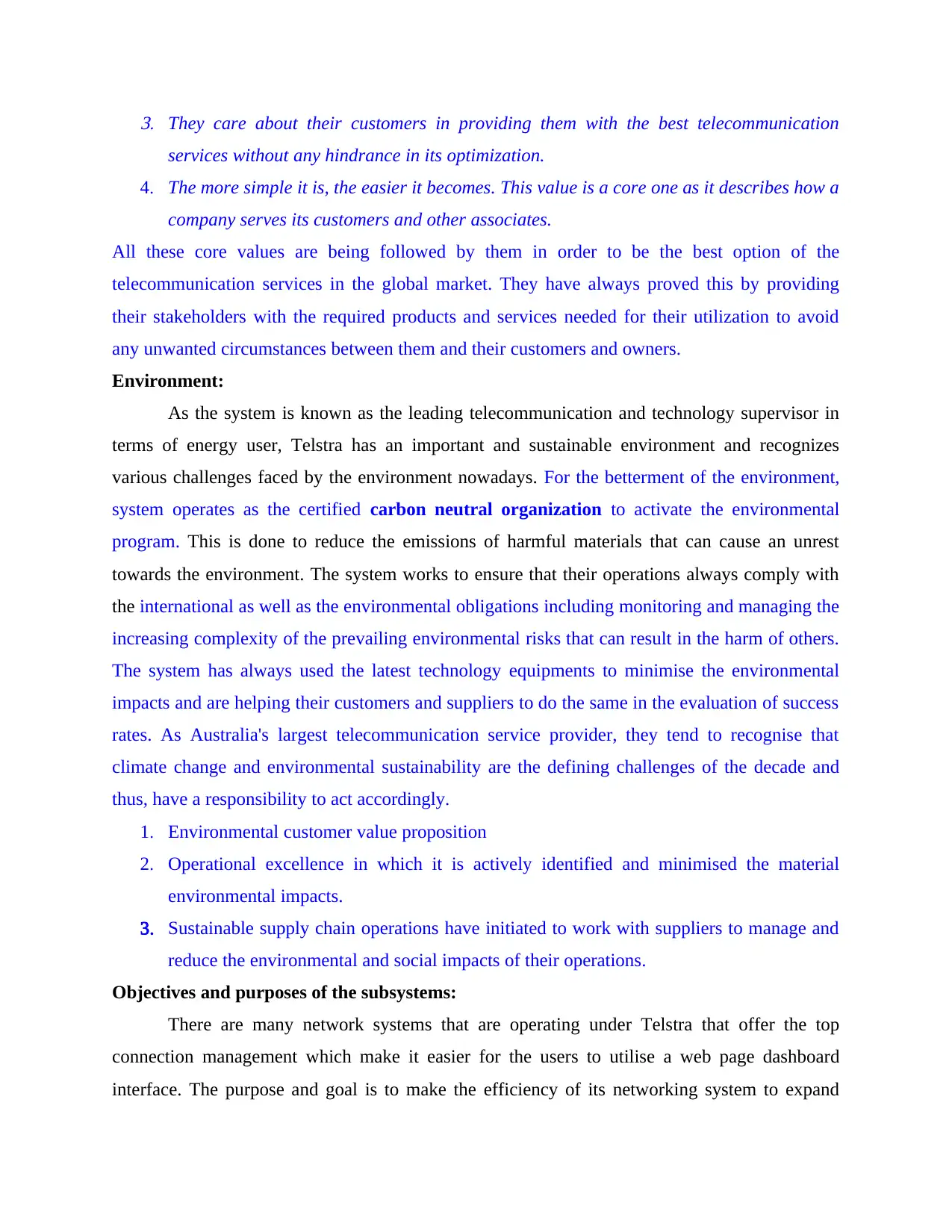
3. They care about their customers in providing them with the best telecommunication
services without any hindrance in its optimization.
4. The more simple it is, the easier it becomes. This value is a core one as it describes how a
company serves its customers and other associates.
All these core values are being followed by them in order to be the best option of the
telecommunication services in the global market. They have always proved this by providing
their stakeholders with the required products and services needed for their utilization to avoid
any unwanted circumstances between them and their customers and owners.
Environment:
As the system is known as the leading telecommunication and technology supervisor in
terms of energy user, Telstra has an important and sustainable environment and recognizes
various challenges faced by the environment nowadays. For the betterment of the environment,
system operates as the certified carbon neutral organization to activate the environmental
program. This is done to reduce the emissions of harmful materials that can cause an unrest
towards the environment. The system works to ensure that their operations always comply with
the international as well as the environmental obligations including monitoring and managing the
increasing complexity of the prevailing environmental risks that can result in the harm of others.
The system has always used the latest technology equipments to minimise the environmental
impacts and are helping their customers and suppliers to do the same in the evaluation of success
rates. As Australia's largest telecommunication service provider, they tend to recognise that
climate change and environmental sustainability are the defining challenges of the decade and
thus, have a responsibility to act accordingly.
1. Environmental customer value proposition
2. Operational excellence in which it is actively identified and minimised the material
environmental impacts.
3. Sustainable supply chain operations have initiated to work with suppliers to manage and
reduce the environmental and social impacts of their operations.
Objectives and purposes of the subsystems:
There are many network systems that are operating under Telstra that offer the top
connection management which make it easier for the users to utilise a web page dashboard
interface. The purpose and goal is to make the efficiency of its networking system to expand
services without any hindrance in its optimization.
4. The more simple it is, the easier it becomes. This value is a core one as it describes how a
company serves its customers and other associates.
All these core values are being followed by them in order to be the best option of the
telecommunication services in the global market. They have always proved this by providing
their stakeholders with the required products and services needed for their utilization to avoid
any unwanted circumstances between them and their customers and owners.
Environment:
As the system is known as the leading telecommunication and technology supervisor in
terms of energy user, Telstra has an important and sustainable environment and recognizes
various challenges faced by the environment nowadays. For the betterment of the environment,
system operates as the certified carbon neutral organization to activate the environmental
program. This is done to reduce the emissions of harmful materials that can cause an unrest
towards the environment. The system works to ensure that their operations always comply with
the international as well as the environmental obligations including monitoring and managing the
increasing complexity of the prevailing environmental risks that can result in the harm of others.
The system has always used the latest technology equipments to minimise the environmental
impacts and are helping their customers and suppliers to do the same in the evaluation of success
rates. As Australia's largest telecommunication service provider, they tend to recognise that
climate change and environmental sustainability are the defining challenges of the decade and
thus, have a responsibility to act accordingly.
1. Environmental customer value proposition
2. Operational excellence in which it is actively identified and minimised the material
environmental impacts.
3. Sustainable supply chain operations have initiated to work with suppliers to manage and
reduce the environmental and social impacts of their operations.
Objectives and purposes of the subsystems:
There are many network systems that are operating under Telstra that offer the top
connection management which make it easier for the users to utilise a web page dashboard
interface. The purpose and goal is to make the efficiency of its networking system to expand
Paraphrase This Document
Need a fresh take? Get an instant paraphrase of this document with our AI Paraphraser
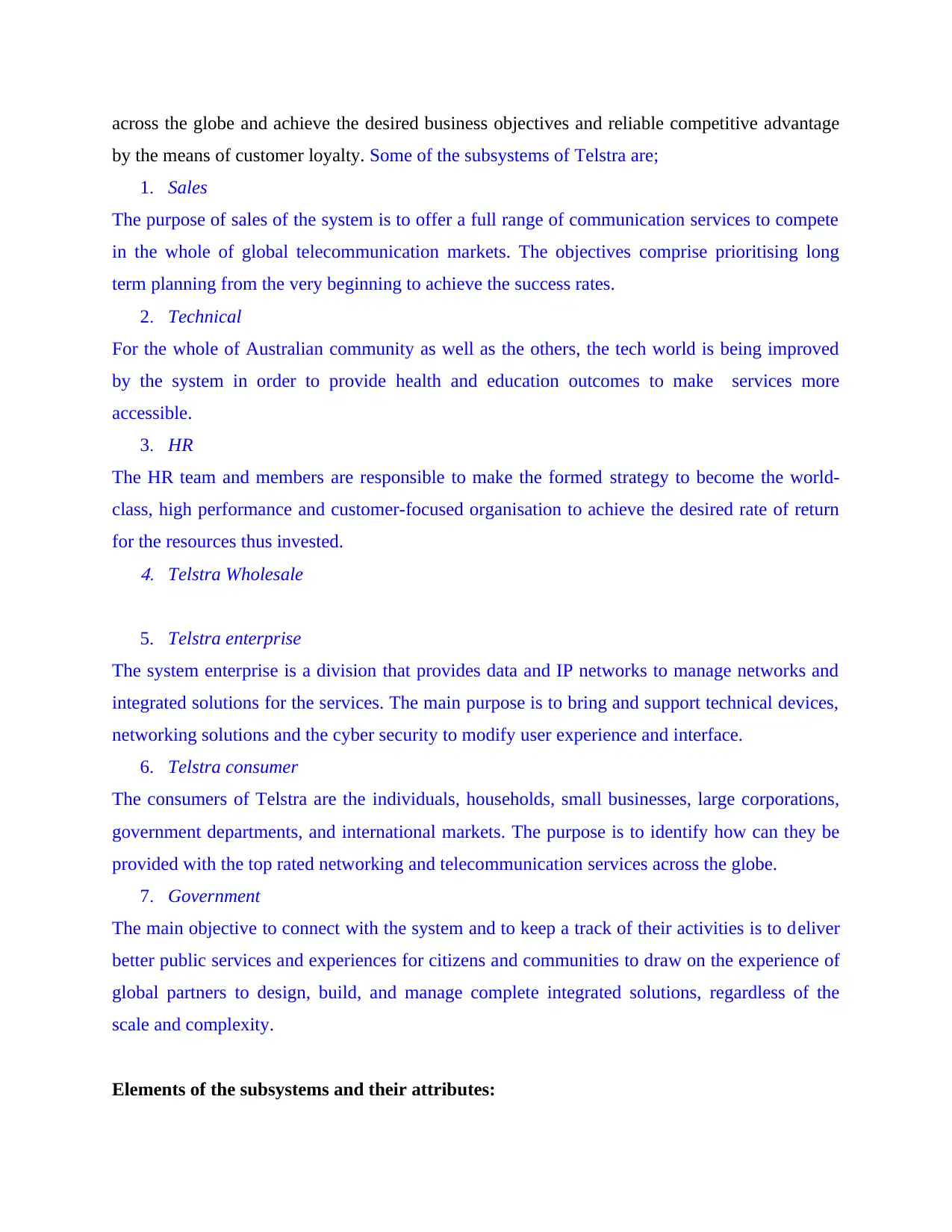
across the globe and achieve the desired business objectives and reliable competitive advantage
by the means of customer loyalty. Some of the subsystems of Telstra are;
1. Sales
The purpose of sales of the system is to offer a full range of communication services to compete
in the whole of global telecommunication markets. The objectives comprise prioritising long
term planning from the very beginning to achieve the success rates.
2. Technical
For the whole of Australian community as well as the others, the tech world is being improved
by the system in order to provide health and education outcomes to make services more
accessible.
3. HR
The HR team and members are responsible to make the formed strategy to become the world-
class, high performance and customer-focused organisation to achieve the desired rate of return
for the resources thus invested.4. Telstra Wholesale
5. Telstra enterprise
The system enterprise is a division that provides data and IP networks to manage networks and
integrated solutions for the services. The main purpose is to bring and support technical devices,
networking solutions and the cyber security to modify user experience and interface.
6. Telstra consumer
The consumers of Telstra are the individuals, households, small businesses, large corporations,
government departments, and international markets. The purpose is to identify how can they be
provided with the top rated networking and telecommunication services across the globe.
7. Government
The main objective to connect with the system and to keep a track of their activities is to deliver
better public services and experiences for citizens and communities to draw on the experience of
global partners to design, build, and manage complete integrated solutions, regardless of the
scale and complexity.
Elements of the subsystems and their attributes:
by the means of customer loyalty. Some of the subsystems of Telstra are;
1. Sales
The purpose of sales of the system is to offer a full range of communication services to compete
in the whole of global telecommunication markets. The objectives comprise prioritising long
term planning from the very beginning to achieve the success rates.
2. Technical
For the whole of Australian community as well as the others, the tech world is being improved
by the system in order to provide health and education outcomes to make services more
accessible.
3. HR
The HR team and members are responsible to make the formed strategy to become the world-
class, high performance and customer-focused organisation to achieve the desired rate of return
for the resources thus invested.4. Telstra Wholesale
5. Telstra enterprise
The system enterprise is a division that provides data and IP networks to manage networks and
integrated solutions for the services. The main purpose is to bring and support technical devices,
networking solutions and the cyber security to modify user experience and interface.
6. Telstra consumer
The consumers of Telstra are the individuals, households, small businesses, large corporations,
government departments, and international markets. The purpose is to identify how can they be
provided with the top rated networking and telecommunication services across the globe.
7. Government
The main objective to connect with the system and to keep a track of their activities is to deliver
better public services and experiences for citizens and communities to draw on the experience of
global partners to design, build, and manage complete integrated solutions, regardless of the
scale and complexity.
Elements of the subsystems and their attributes:
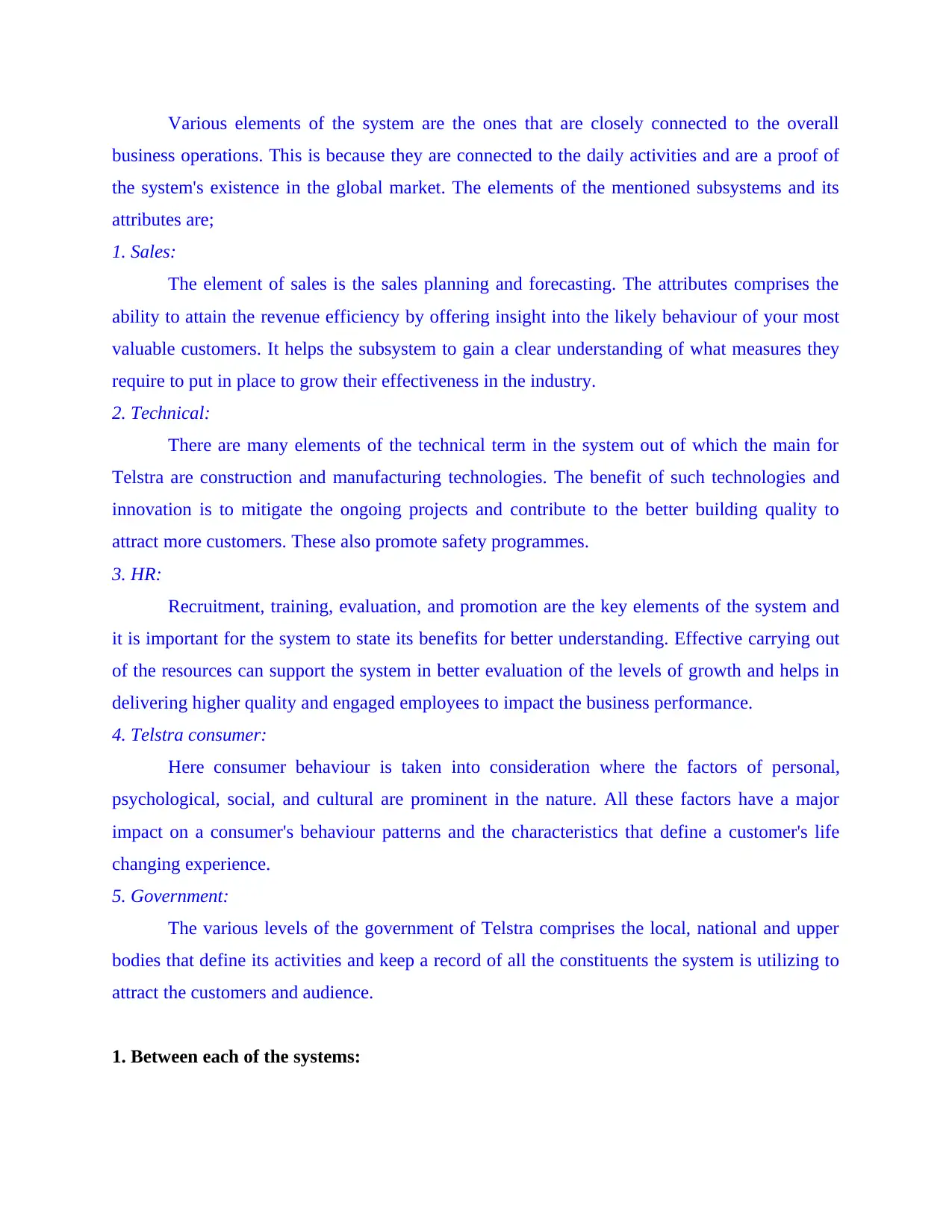
Various elements of the system are the ones that are closely connected to the overall
business operations. This is because they are connected to the daily activities and are a proof of
the system's existence in the global market. The elements of the mentioned subsystems and its
attributes are;
1. Sales:
The element of sales is the sales planning and forecasting. The attributes comprises the
ability to attain the revenue efficiency by offering insight into the likely behaviour of your most
valuable customers. It helps the subsystem to gain a clear understanding of what measures they
require to put in place to grow their effectiveness in the industry.
2. Technical:
There are many elements of the technical term in the system out of which the main for
Telstra are construction and manufacturing technologies. The benefit of such technologies and
innovation is to mitigate the ongoing projects and contribute to the better building quality to
attract more customers. These also promote safety programmes.
3. HR:
Recruitment, training, evaluation, and promotion are the key elements of the system and
it is important for the system to state its benefits for better understanding. Effective carrying out
of the resources can support the system in better evaluation of the levels of growth and helps in
delivering higher quality and engaged employees to impact the business performance.
4. Telstra consumer:
Here consumer behaviour is taken into consideration where the factors of personal,
psychological, social, and cultural are prominent in the nature. All these factors have a major
impact on a consumer's behaviour patterns and the characteristics that define a customer's life
changing experience.
5. Government:
The various levels of the government of Telstra comprises the local, national and upper
bodies that define its activities and keep a record of all the constituents the system is utilizing to
attract the customers and audience.
1. Between each of the systems:
business operations. This is because they are connected to the daily activities and are a proof of
the system's existence in the global market. The elements of the mentioned subsystems and its
attributes are;
1. Sales:
The element of sales is the sales planning and forecasting. The attributes comprises the
ability to attain the revenue efficiency by offering insight into the likely behaviour of your most
valuable customers. It helps the subsystem to gain a clear understanding of what measures they
require to put in place to grow their effectiveness in the industry.
2. Technical:
There are many elements of the technical term in the system out of which the main for
Telstra are construction and manufacturing technologies. The benefit of such technologies and
innovation is to mitigate the ongoing projects and contribute to the better building quality to
attract more customers. These also promote safety programmes.
3. HR:
Recruitment, training, evaluation, and promotion are the key elements of the system and
it is important for the system to state its benefits for better understanding. Effective carrying out
of the resources can support the system in better evaluation of the levels of growth and helps in
delivering higher quality and engaged employees to impact the business performance.
4. Telstra consumer:
Here consumer behaviour is taken into consideration where the factors of personal,
psychological, social, and cultural are prominent in the nature. All these factors have a major
impact on a consumer's behaviour patterns and the characteristics that define a customer's life
changing experience.
5. Government:
The various levels of the government of Telstra comprises the local, national and upper
bodies that define its activities and keep a record of all the constituents the system is utilizing to
attract the customers and audience.
1. Between each of the systems:
⊘ This is a preview!⊘
Do you want full access?
Subscribe today to unlock all pages.

Trusted by 1+ million students worldwide
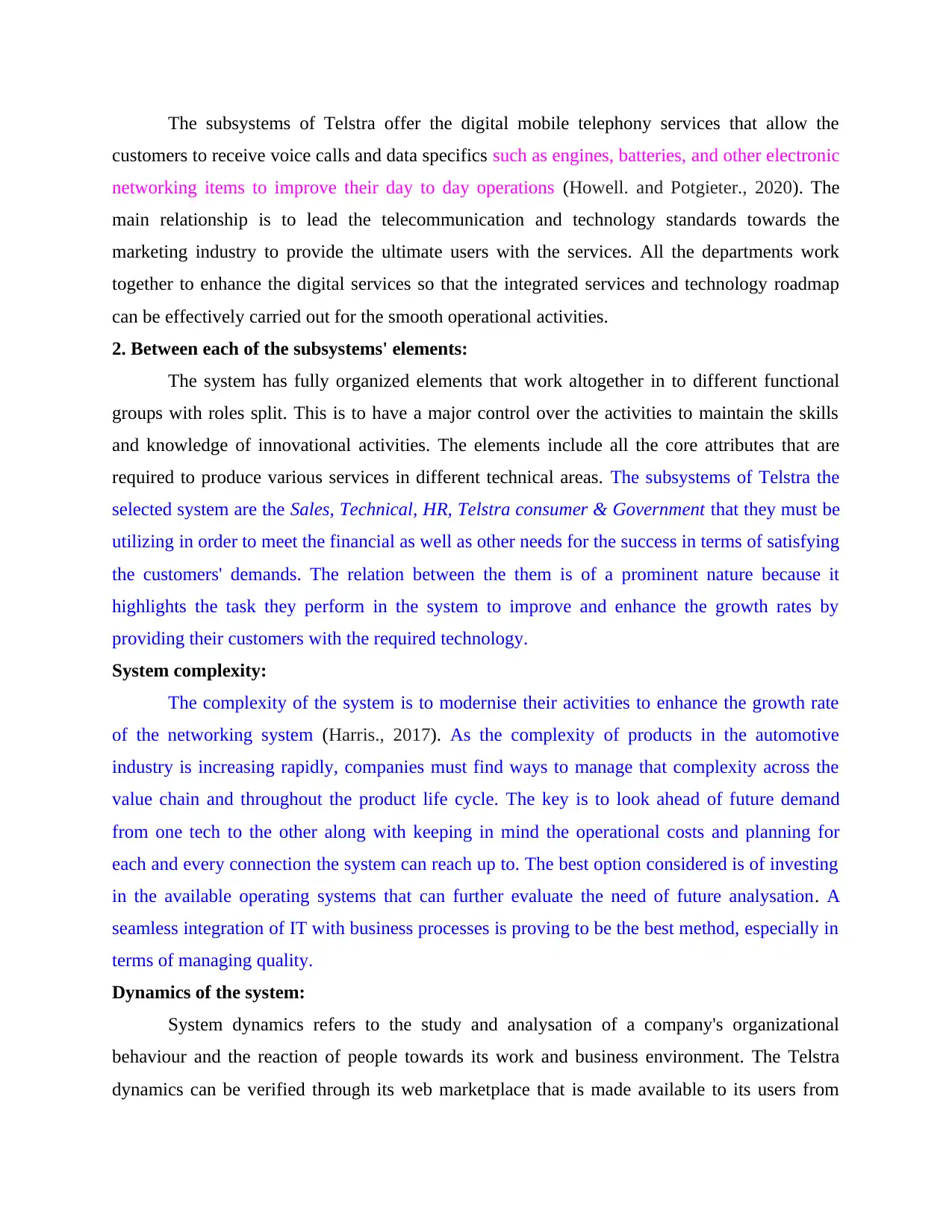
The subsystems of Telstra offer the digital mobile telephony services that allow the
customers to receive voice calls and data specifics such as engines, batteries, and other electronic
networking items to improve their day to day operations (Howell. and Potgieter., 2020). The
main relationship is to lead the telecommunication and technology standards towards the
marketing industry to provide the ultimate users with the services. All the departments work
together to enhance the digital services so that the integrated services and technology roadmap
can be effectively carried out for the smooth operational activities.
2. Between each of the subsystems' elements:
The system has fully organized elements that work altogether in to different functional
groups with roles split. This is to have a major control over the activities to maintain the skills
and knowledge of innovational activities. The elements include all the core attributes that are
required to produce various services in different technical areas. The subsystems of Telstra the
selected system are the Sales, Technical, HR, Telstra consumer & Government that they must be
utilizing in order to meet the financial as well as other needs for the success in terms of satisfying
the customers' demands. The relation between the them is of a prominent nature because it
highlights the task they perform in the system to improve and enhance the growth rates by
providing their customers with the required technology.
System complexity:
The complexity of the system is to modernise their activities to enhance the growth rate
of the networking system (Harris., 2017). As the complexity of products in the automotive
industry is increasing rapidly, companies must find ways to manage that complexity across the
value chain and throughout the product life cycle. The key is to look ahead of future demand
from one tech to the other along with keeping in mind the operational costs and planning for
each and every connection the system can reach up to. The best option considered is of investing
in the available operating systems that can further evaluate the need of future analysation. A
seamless integration of IT with business processes is proving to be the best method, especially in
terms of managing quality.
Dynamics of the system:
System dynamics refers to the study and analysation of a company's organizational
behaviour and the reaction of people towards its work and business environment. The Telstra
dynamics can be verified through its web marketplace that is made available to its users from
customers to receive voice calls and data specifics such as engines, batteries, and other electronic
networking items to improve their day to day operations (Howell. and Potgieter., 2020). The
main relationship is to lead the telecommunication and technology standards towards the
marketing industry to provide the ultimate users with the services. All the departments work
together to enhance the digital services so that the integrated services and technology roadmap
can be effectively carried out for the smooth operational activities.
2. Between each of the subsystems' elements:
The system has fully organized elements that work altogether in to different functional
groups with roles split. This is to have a major control over the activities to maintain the skills
and knowledge of innovational activities. The elements include all the core attributes that are
required to produce various services in different technical areas. The subsystems of Telstra the
selected system are the Sales, Technical, HR, Telstra consumer & Government that they must be
utilizing in order to meet the financial as well as other needs for the success in terms of satisfying
the customers' demands. The relation between the them is of a prominent nature because it
highlights the task they perform in the system to improve and enhance the growth rates by
providing their customers with the required technology.
System complexity:
The complexity of the system is to modernise their activities to enhance the growth rate
of the networking system (Harris., 2017). As the complexity of products in the automotive
industry is increasing rapidly, companies must find ways to manage that complexity across the
value chain and throughout the product life cycle. The key is to look ahead of future demand
from one tech to the other along with keeping in mind the operational costs and planning for
each and every connection the system can reach up to. The best option considered is of investing
in the available operating systems that can further evaluate the need of future analysation. A
seamless integration of IT with business processes is proving to be the best method, especially in
terms of managing quality.
Dynamics of the system:
System dynamics refers to the study and analysation of a company's organizational
behaviour and the reaction of people towards its work and business environment. The Telstra
dynamics can be verified through its web marketplace that is made available to its users from
Paraphrase This Document
Need a fresh take? Get an instant paraphrase of this document with our AI Paraphraser
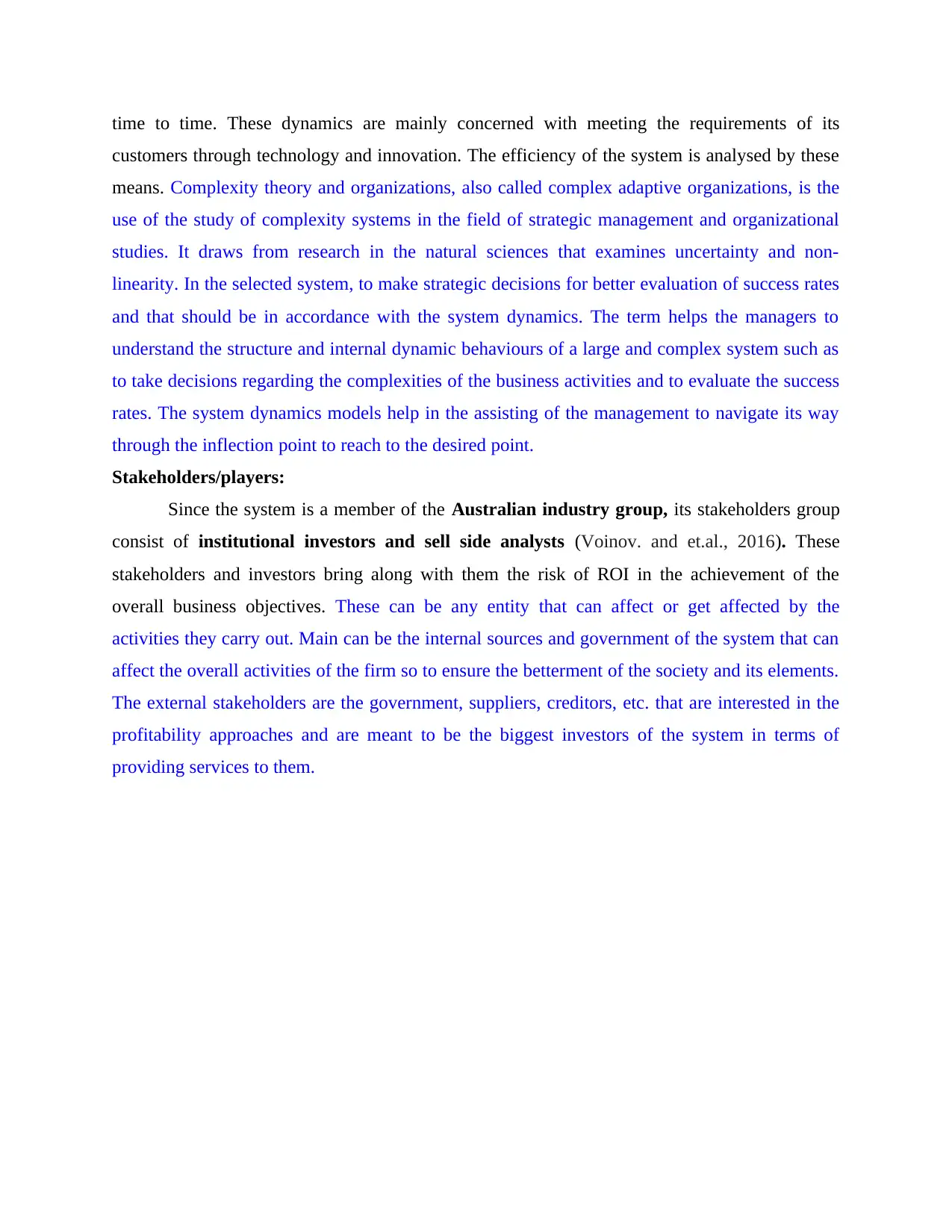
time to time. These dynamics are mainly concerned with meeting the requirements of its
customers through technology and innovation. The efficiency of the system is analysed by these
means. Complexity theory and organizations, also called complex adaptive organizations, is the
use of the study of complexity systems in the field of strategic management and organizational
studies. It draws from research in the natural sciences that examines uncertainty and non-
linearity. In the selected system, to make strategic decisions for better evaluation of success rates
and that should be in accordance with the system dynamics. The term helps the managers to
understand the structure and internal dynamic behaviours of a large and complex system such as
to take decisions regarding the complexities of the business activities and to evaluate the success
rates. The system dynamics models help in the assisting of the management to navigate its way
through the inflection point to reach to the desired point.
Stakeholders/players:
Since the system is a member of the Australian industry group, its stakeholders group
consist of institutional investors and sell side analysts (Voinov. and et.al., 2016). These
stakeholders and investors bring along with them the risk of ROI in the achievement of the
overall business objectives. These can be any entity that can affect or get affected by the
activities they carry out. Main can be the internal sources and government of the system that can
affect the overall activities of the firm so to ensure the betterment of the society and its elements.
The external stakeholders are the government, suppliers, creditors, etc. that are interested in the
profitability approaches and are meant to be the biggest investors of the system in terms of
providing services to them.
customers through technology and innovation. The efficiency of the system is analysed by these
means. Complexity theory and organizations, also called complex adaptive organizations, is the
use of the study of complexity systems in the field of strategic management and organizational
studies. It draws from research in the natural sciences that examines uncertainty and non-
linearity. In the selected system, to make strategic decisions for better evaluation of success rates
and that should be in accordance with the system dynamics. The term helps the managers to
understand the structure and internal dynamic behaviours of a large and complex system such as
to take decisions regarding the complexities of the business activities and to evaluate the success
rates. The system dynamics models help in the assisting of the management to navigate its way
through the inflection point to reach to the desired point.
Stakeholders/players:
Since the system is a member of the Australian industry group, its stakeholders group
consist of institutional investors and sell side analysts (Voinov. and et.al., 2016). These
stakeholders and investors bring along with them the risk of ROI in the achievement of the
overall business objectives. These can be any entity that can affect or get affected by the
activities they carry out. Main can be the internal sources and government of the system that can
affect the overall activities of the firm so to ensure the betterment of the society and its elements.
The external stakeholders are the government, suppliers, creditors, etc. that are interested in the
profitability approaches and are meant to be the biggest investors of the system in terms of
providing services to them.

⊘ This is a preview!⊘
Do you want full access?
Subscribe today to unlock all pages.

Trusted by 1+ million students worldwide
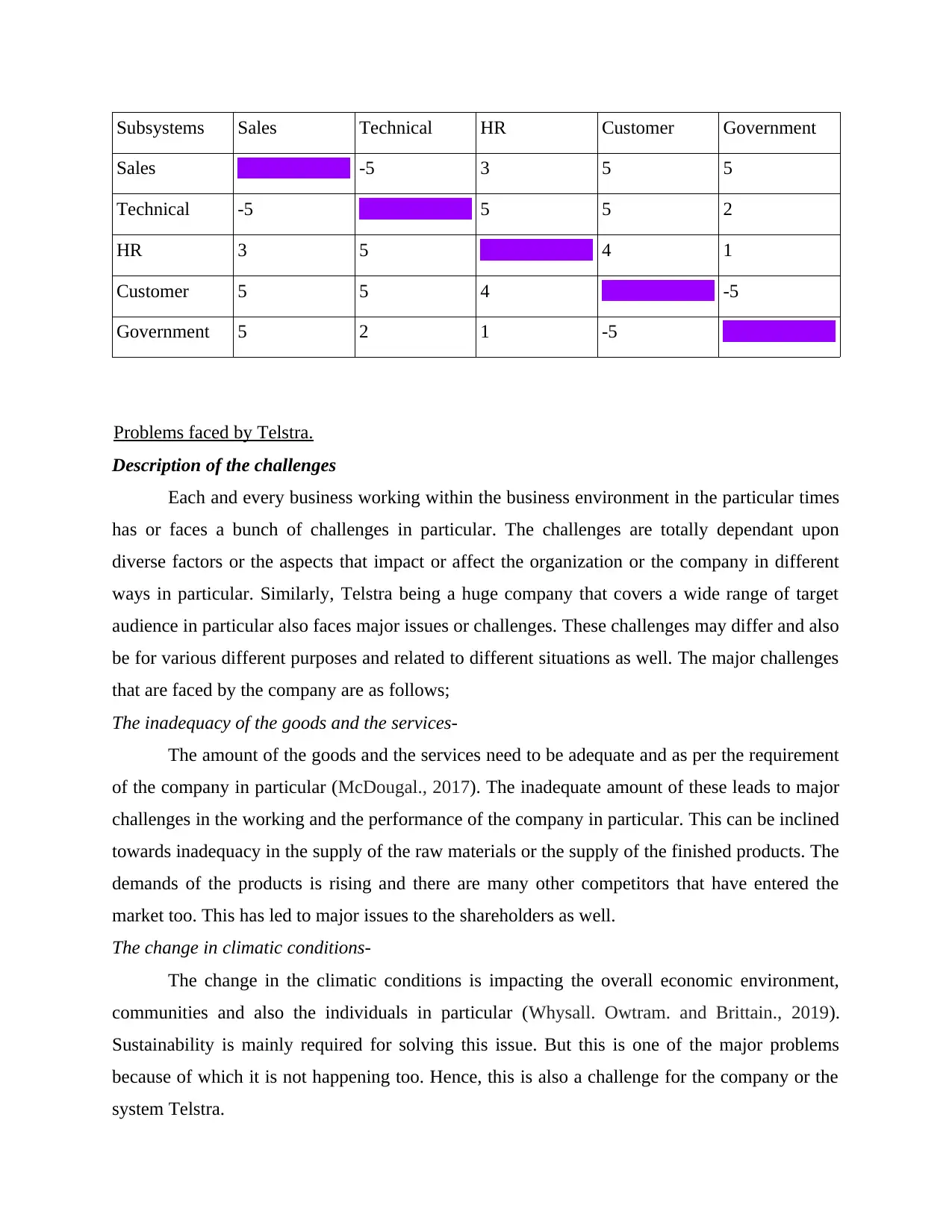
Subsystems Sales Technical HR Customer Government
Sales -5 3 5 5
Technical -5 5 5 2
HR 3 5 4 1
Customer 5 5 4 -5
Government 5 2 1 -5
Problems faced by Telstra.
Description of the challenges
Each and every business working within the business environment in the particular times
has or faces a bunch of challenges in particular. The challenges are totally dependant upon
diverse factors or the aspects that impact or affect the organization or the company in different
ways in particular. Similarly, Telstra being a huge company that covers a wide range of target
audience in particular also faces major issues or challenges. These challenges may differ and also
be for various different purposes and related to different situations as well. The major challenges
that are faced by the company are as follows;
The inadequacy of the goods and the services-
The amount of the goods and the services need to be adequate and as per the requirement
of the company in particular (McDougal., 2017). The inadequate amount of these leads to major
challenges in the working and the performance of the company in particular. This can be inclined
towards inadequacy in the supply of the raw materials or the supply of the finished products. The
demands of the products is rising and there are many other competitors that have entered the
market too. This has led to major issues to the shareholders as well.
The change in climatic conditions-
The change in the climatic conditions is impacting the overall economic environment,
communities and also the individuals in particular (Whysall. Owtram. and Brittain., 2019).
Sustainability is mainly required for solving this issue. But this is one of the major problems
because of which it is not happening too. Hence, this is also a challenge for the company or the
system Telstra.
Sales -5 3 5 5
Technical -5 5 5 2
HR 3 5 4 1
Customer 5 5 4 -5
Government 5 2 1 -5
Problems faced by Telstra.
Description of the challenges
Each and every business working within the business environment in the particular times
has or faces a bunch of challenges in particular. The challenges are totally dependant upon
diverse factors or the aspects that impact or affect the organization or the company in different
ways in particular. Similarly, Telstra being a huge company that covers a wide range of target
audience in particular also faces major issues or challenges. These challenges may differ and also
be for various different purposes and related to different situations as well. The major challenges
that are faced by the company are as follows;
The inadequacy of the goods and the services-
The amount of the goods and the services need to be adequate and as per the requirement
of the company in particular (McDougal., 2017). The inadequate amount of these leads to major
challenges in the working and the performance of the company in particular. This can be inclined
towards inadequacy in the supply of the raw materials or the supply of the finished products. The
demands of the products is rising and there are many other competitors that have entered the
market too. This has led to major issues to the shareholders as well.
The change in climatic conditions-
The change in the climatic conditions is impacting the overall economic environment,
communities and also the individuals in particular (Whysall. Owtram. and Brittain., 2019).
Sustainability is mainly required for solving this issue. But this is one of the major problems
because of which it is not happening too. Hence, this is also a challenge for the company or the
system Telstra.
Paraphrase This Document
Need a fresh take? Get an instant paraphrase of this document with our AI Paraphraser
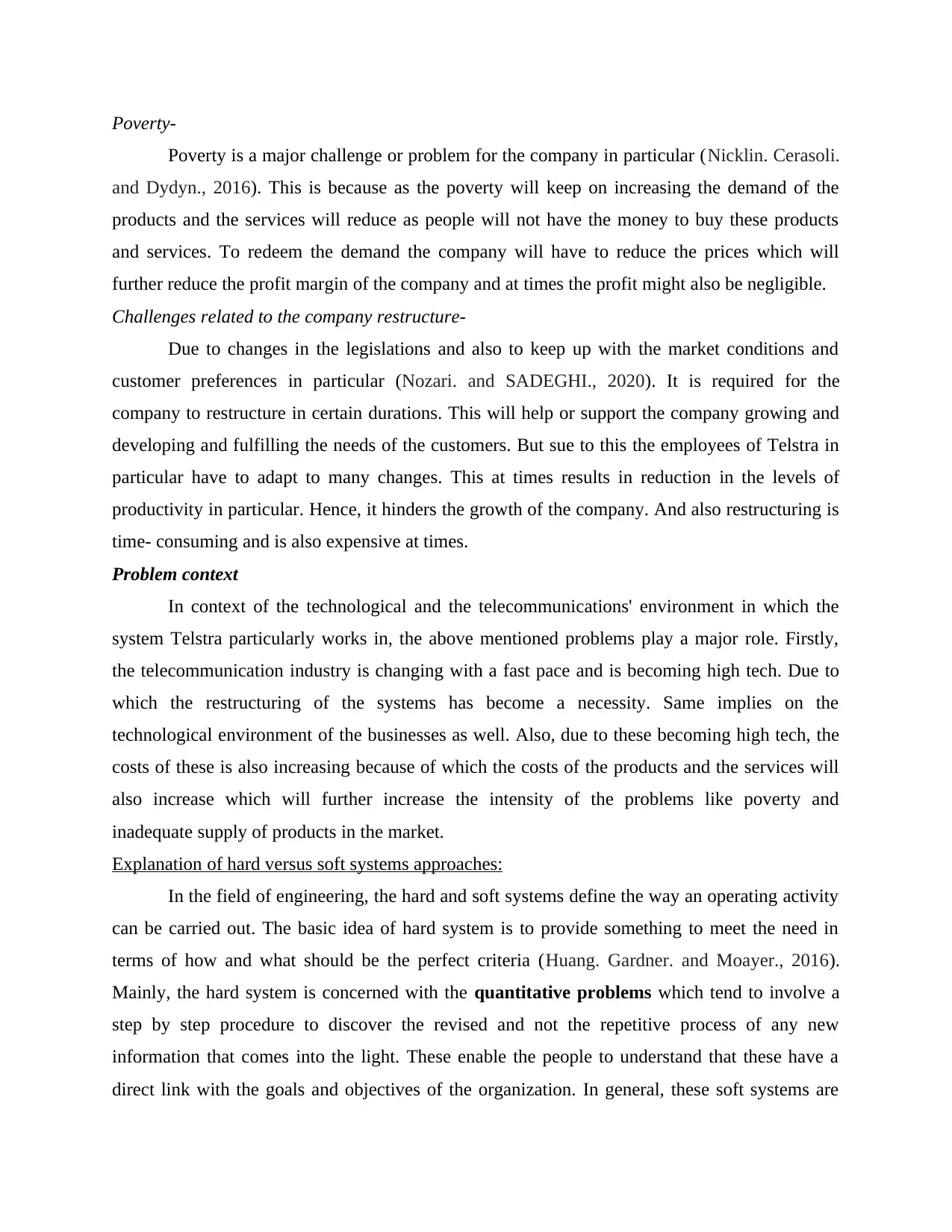
Poverty-
Poverty is a major challenge or problem for the company in particular (Nicklin. Cerasoli.
and Dydyn., 2016). This is because as the poverty will keep on increasing the demand of the
products and the services will reduce as people will not have the money to buy these products
and services. To redeem the demand the company will have to reduce the prices which will
further reduce the profit margin of the company and at times the profit might also be negligible.
Challenges related to the company restructure-
Due to changes in the legislations and also to keep up with the market conditions and
customer preferences in particular (Nozari. and SADEGHI., 2020). It is required for the
company to restructure in certain durations. This will help or support the company growing and
developing and fulfilling the needs of the customers. But sue to this the employees of Telstra in
particular have to adapt to many changes. This at times results in reduction in the levels of
productivity in particular. Hence, it hinders the growth of the company. And also restructuring is
time- consuming and is also expensive at times.
Problem context
In context of the technological and the telecommunications' environment in which the
system Telstra particularly works in, the above mentioned problems play a major role. Firstly,
the telecommunication industry is changing with a fast pace and is becoming high tech. Due to
which the restructuring of the systems has become a necessity. Same implies on the
technological environment of the businesses as well. Also, due to these becoming high tech, the
costs of these is also increasing because of which the costs of the products and the services will
also increase which will further increase the intensity of the problems like poverty and
inadequate supply of products in the market.
Explanation of hard versus soft systems approaches:
In the field of engineering, the hard and soft systems define the way an operating activity
can be carried out. The basic idea of hard system is to provide something to meet the need in
terms of how and what should be the perfect criteria (Huang. Gardner. and Moayer., 2016).
Mainly, the hard system is concerned with the quantitative problems which tend to involve a
step by step procedure to discover the revised and not the repetitive process of any new
information that comes into the light. These enable the people to understand that these have a
direct link with the goals and objectives of the organization. In general, these soft systems are
Poverty is a major challenge or problem for the company in particular (Nicklin. Cerasoli.
and Dydyn., 2016). This is because as the poverty will keep on increasing the demand of the
products and the services will reduce as people will not have the money to buy these products
and services. To redeem the demand the company will have to reduce the prices which will
further reduce the profit margin of the company and at times the profit might also be negligible.
Challenges related to the company restructure-
Due to changes in the legislations and also to keep up with the market conditions and
customer preferences in particular (Nozari. and SADEGHI., 2020). It is required for the
company to restructure in certain durations. This will help or support the company growing and
developing and fulfilling the needs of the customers. But sue to this the employees of Telstra in
particular have to adapt to many changes. This at times results in reduction in the levels of
productivity in particular. Hence, it hinders the growth of the company. And also restructuring is
time- consuming and is also expensive at times.
Problem context
In context of the technological and the telecommunications' environment in which the
system Telstra particularly works in, the above mentioned problems play a major role. Firstly,
the telecommunication industry is changing with a fast pace and is becoming high tech. Due to
which the restructuring of the systems has become a necessity. Same implies on the
technological environment of the businesses as well. Also, due to these becoming high tech, the
costs of these is also increasing because of which the costs of the products and the services will
also increase which will further increase the intensity of the problems like poverty and
inadequate supply of products in the market.
Explanation of hard versus soft systems approaches:
In the field of engineering, the hard and soft systems define the way an operating activity
can be carried out. The basic idea of hard system is to provide something to meet the need in
terms of how and what should be the perfect criteria (Huang. Gardner. and Moayer., 2016).
Mainly, the hard system is concerned with the quantitative problems which tend to involve a
step by step procedure to discover the revised and not the repetitive process of any new
information that comes into the light. These enable the people to understand that these have a
direct link with the goals and objectives of the organization. In general, these soft systems are
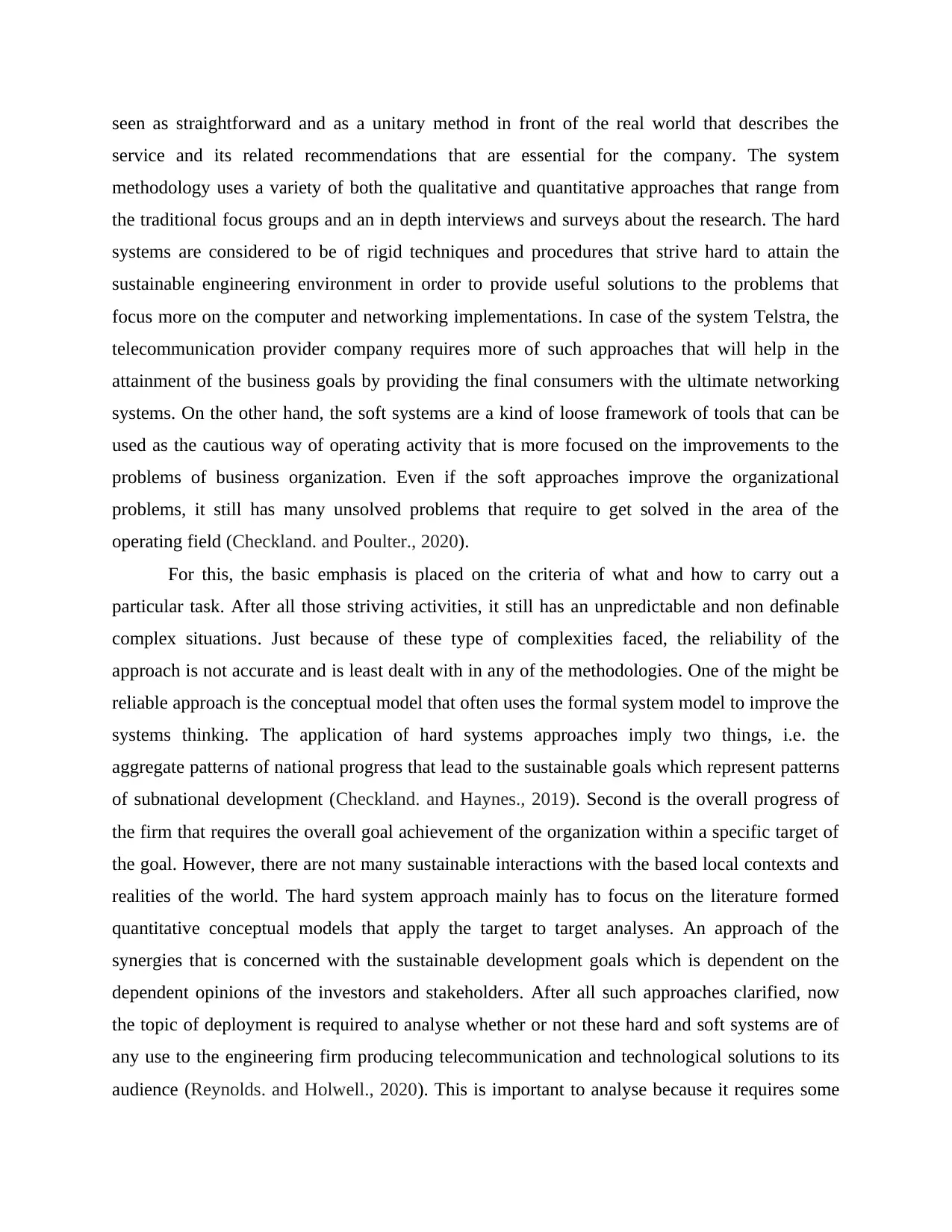
seen as straightforward and as a unitary method in front of the real world that describes the
service and its related recommendations that are essential for the company. The system
methodology uses a variety of both the qualitative and quantitative approaches that range from
the traditional focus groups and an in depth interviews and surveys about the research. The hard
systems are considered to be of rigid techniques and procedures that strive hard to attain the
sustainable engineering environment in order to provide useful solutions to the problems that
focus more on the computer and networking implementations. In case of the system Telstra, the
telecommunication provider company requires more of such approaches that will help in the
attainment of the business goals by providing the final consumers with the ultimate networking
systems. On the other hand, the soft systems are a kind of loose framework of tools that can be
used as the cautious way of operating activity that is more focused on the improvements to the
problems of business organization. Even if the soft approaches improve the organizational
problems, it still has many unsolved problems that require to get solved in the area of the
operating field (Checkland. and Poulter., 2020).
For this, the basic emphasis is placed on the criteria of what and how to carry out a
particular task. After all those striving activities, it still has an unpredictable and non definable
complex situations. Just because of these type of complexities faced, the reliability of the
approach is not accurate and is least dealt with in any of the methodologies. One of the might be
reliable approach is the conceptual model that often uses the formal system model to improve the
systems thinking. The application of hard systems approaches imply two things, i.e. the
aggregate patterns of national progress that lead to the sustainable goals which represent patterns
of subnational development (Checkland. and Haynes., 2019). Second is the overall progress of
the firm that requires the overall goal achievement of the organization within a specific target of
the goal. However, there are not many sustainable interactions with the based local contexts and
realities of the world. The hard system approach mainly has to focus on the literature formed
quantitative conceptual models that apply the target to target analyses. An approach of the
synergies that is concerned with the sustainable development goals which is dependent on the
dependent opinions of the investors and stakeholders. After all such approaches clarified, now
the topic of deployment is required to analyse whether or not these hard and soft systems are of
any use to the engineering firm producing telecommunication and technological solutions to its
audience (Reynolds. and Holwell., 2020). This is important to analyse because it requires some
service and its related recommendations that are essential for the company. The system
methodology uses a variety of both the qualitative and quantitative approaches that range from
the traditional focus groups and an in depth interviews and surveys about the research. The hard
systems are considered to be of rigid techniques and procedures that strive hard to attain the
sustainable engineering environment in order to provide useful solutions to the problems that
focus more on the computer and networking implementations. In case of the system Telstra, the
telecommunication provider company requires more of such approaches that will help in the
attainment of the business goals by providing the final consumers with the ultimate networking
systems. On the other hand, the soft systems are a kind of loose framework of tools that can be
used as the cautious way of operating activity that is more focused on the improvements to the
problems of business organization. Even if the soft approaches improve the organizational
problems, it still has many unsolved problems that require to get solved in the area of the
operating field (Checkland. and Poulter., 2020).
For this, the basic emphasis is placed on the criteria of what and how to carry out a
particular task. After all those striving activities, it still has an unpredictable and non definable
complex situations. Just because of these type of complexities faced, the reliability of the
approach is not accurate and is least dealt with in any of the methodologies. One of the might be
reliable approach is the conceptual model that often uses the formal system model to improve the
systems thinking. The application of hard systems approaches imply two things, i.e. the
aggregate patterns of national progress that lead to the sustainable goals which represent patterns
of subnational development (Checkland. and Haynes., 2019). Second is the overall progress of
the firm that requires the overall goal achievement of the organization within a specific target of
the goal. However, there are not many sustainable interactions with the based local contexts and
realities of the world. The hard system approach mainly has to focus on the literature formed
quantitative conceptual models that apply the target to target analyses. An approach of the
synergies that is concerned with the sustainable development goals which is dependent on the
dependent opinions of the investors and stakeholders. After all such approaches clarified, now
the topic of deployment is required to analyse whether or not these hard and soft systems are of
any use to the engineering firm producing telecommunication and technological solutions to its
audience (Reynolds. and Holwell., 2020). This is important to analyse because it requires some
⊘ This is a preview!⊘
Do you want full access?
Subscribe today to unlock all pages.

Trusted by 1+ million students worldwide
1 out of 17
Related Documents
Your All-in-One AI-Powered Toolkit for Academic Success.
+13062052269
info@desklib.com
Available 24*7 on WhatsApp / Email
![[object Object]](/_next/static/media/star-bottom.7253800d.svg)
Unlock your academic potential
Copyright © 2020–2025 A2Z Services. All Rights Reserved. Developed and managed by ZUCOL.





